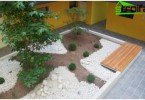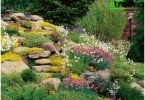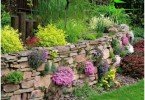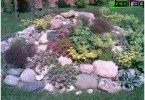Are you so busy that you don’t have time to decorate your site? Cheer up, landscape designers have developed a new way to decorate gardens and parks – this is a gravel garden. It is increasingly replacing lawns, flowerbeds and alpine hills. It can be considered another fashionable “chip”, which attracts the attention of others..
Content
- Features of the new design
- Benefits of Gravel Gardens
- Gravel garden construction technology
- What plants are suitable for a stone garden
Features of the new design
What is the feature of the new direction in landscape design?
- It includes compositions of stunted steppe and mountain plants, which are planted on the background of dumping their gravel.
- Unlike rockeries and alpine slides, there is no need for large stones, so creating a gravel garden does not require much effort.
- The variety of plant compositions located on a uniform background of fine gravel and pebbles looks just great.
- Bright colored spots formed by different plants can both harmonize with each other and look contrasted. Such a garden is similar to the steppe landscape, where single groups of plants are scattered in the desert.
This style added to the beauty of the decorated paths of colored gravel (which the gardens of Europe are famous for), the mysterious silence of the stone gardens of Japan. In the end result, we have a minimum of worries about caring for plants and a maximum of decorativeness of the site.
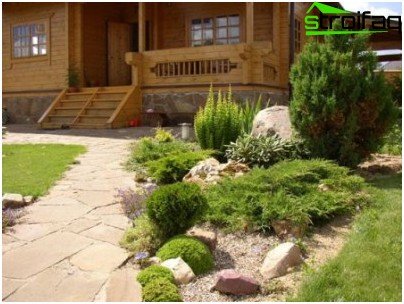
With a gravel garden you can make attractive the most problematic part of the yard
Benefits of Gravel Gardens
Compared with the usual methods of decorating a suburban area, a gravel garden has many advantages:
- landing area is not regulated and may have different sizes. They are determined according to the personal desire and abilities of the land owner;
- you can give a noble look to any corner of your site;
- thanks to the simple technology of work, you can make such a garden on your own;
- its structure and further maintenance does not require large financial investments;
- To create a gravel garden, you can use places that are practically unsuitable for growing plants – this is a wasteland, a shady corner of the garden, or the sun itself;
- correctly selected plants mulched with the help of colored gravel, it is possible to decorate both a small patch of land at the front door and a separately located recreation area;
- if necessary, the plants are easy to transplant, and single seedlings of weeds can be removed in a few minutes.
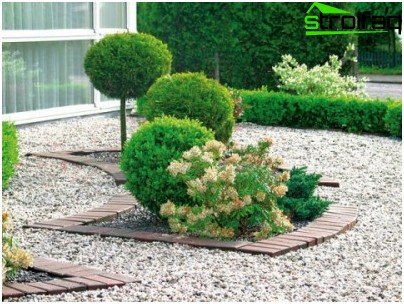
There is a mysterious silence in the stone gardens of Japan. Considering that you do not need to constantly loosen and moisten the soil, as well as spend money on buying flower seedlings and seeds, some gardeners call stony gardens “gardens for the lazy”
Gravel garden construction technology
- Soil preparation
The best option for planting land is light sandy soil, but you can make a garden on a once-well-groomed flowerbed. The boundaries of the intended area are marked with a rope. Sod, as well as 20 cm of the soil layer is removed, after which weed roots are carefully selected. The resulting pit is lightly watered and left for 10 days, after which the remaining sprouted weeds and their roots are removed.
So that the roots of the planted plants do not suffer from excess moisture, drain the soil. How to do it? When digging the earth for each square meter add 2-5 liters of baking powder. It can be vermiculite, coarse or expanded clay sand, brick or granite chips. The soil is slightly compacted by a garden skating rink, after which the foundation pit is covered with black geotextile (density not less than 120 g / m), for example, by stanbond. Such agrofibre is needed to protect against the germination of perennial weeds and from the subsidence of gravel that can occur in loose soil.
Important! When laying geotextiles, remember about sufficient overlap of the joints of paintings. For the outflow of excess moisture, the canvas is pierced, making a small hole in an area of 2.5-3 square meters. meter.
- Gravel Backfill
According to the technology, the pots and seedlings are arranged according to the plan, the result obtained is evaluated, and already after planting, stone aggregate is poured. In practice, as a rule, everything is done the other way around. If the gravel garden occupies a large area, then planting is carried out in several stages. Then dig holes in the gravel and fill them after planting.
Initially, the thickness of the backfill in gravel gardens was 25-30 cm. After applying geotextile, it decreased to 5-10 cm. After washing, the gravel is dark in color. Along with it, landscaping uses stone chips, crushed stone of different colors, shells, colored sea pebbles and other fillers having a diameter of 3-20 cm. To fill a 12-15 meter section, you will need a ton of gravel.
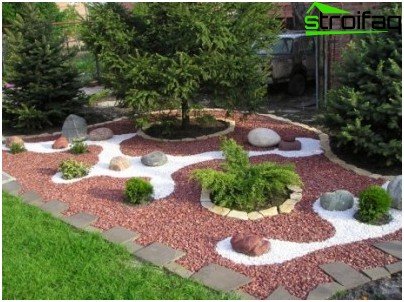
Beauty that does not require much care. On a note! To save the expensive filler needed for the project – marble and granite chips, you can first put cheap river gravel, and then pour 2-3 cm of valuable chips
On a note! To save the expensive filler needed for the project – marble and granite chips, you can first put cheap river gravel, and then pour 2-3 cm of valuable chips
- Planting
Planting begins with shrubs. When they start to grow, carpet and perennial plants are planted. The last planted clumps of lily plants.
In the place designated for planting, gravel is selected, a cross-shaped incision is made in the geotextile, the petals of which are wrapped down. A hole is excavated in the ground corresponding to the root system of the seedling. Its roots are straightened and covered with a layer of earth of 5-6 cm. Then they are watered and squeezed tightly with the ground. The selected gravel is returned to the place, and the planted plant is watered again.
Lastly, the seeds of one- and two-year-old plants are sown, which will later be restored by self-sowing. Annual herbs are sown after maturing in early spring. Two-year-olds are sowed in early June, which will allow them to bloom next year.
What plants are suitable for a stone garden
Moisture-resistant and highly decorative crops feel great in the gravel garden. It is worth paying attention to the need for additional care (division and transplantation).
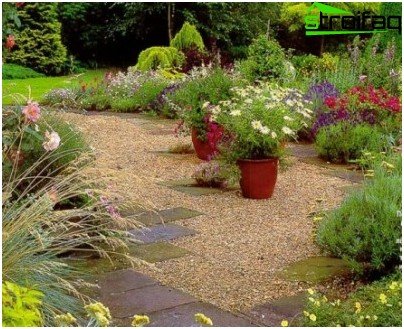
Floral arrangements on a homogeneous background – it’s just fantastic
All year round, pleasing magonium pleases with its appearance. It has dark green shiny leaves, bluish sour berries and yellow tassels of flowers. Host varieties delight the eye with the width of their leaves – they can do without transplantation for several years. Ferns, daylilies and irises will be undemanding to care. Plants having silvery leaves — wormwood, chistek, cineraria, gray fescue, lavender, cloves — look favorably on stones.
You already understood that spending once time, money and effort, you will be happy for a long time about the work of your own hands! Why? Because you preferred the gravel garden!


